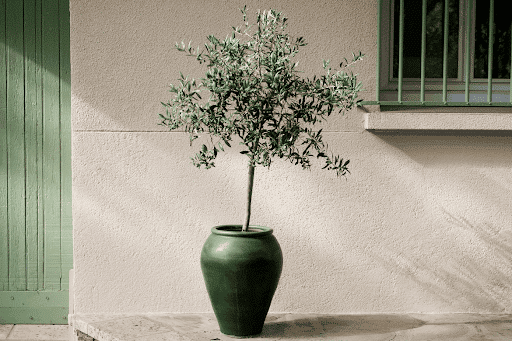
Container gardening is perfect for sprucing up small or temporary outdoor spaces with some greenery. Even if you’re dealing with limited space, poor soil, or an unpredictable climate, you can still cultivate a lively garden full of diverse plants, including trees. Many types of trees can flourish in containers, adding both beauty and practicality to places like patios, balconies, and small yards.
This article will cover 10 tree types ideal for container growth and provide key care tips and the best conditions for each species. Whether you’re looking to enhance your space visually, grow your own fruit, or just enjoy container gardening, these trees make excellent additions to your home garden.
Container Gardening with Trees
Container gardening with trees offers a flexible and portable way to enhance outdoor spaces. You can easily move or re-pott trees in containers, making them ideal for homeowners who may relocate or want to adjust their garden layout. Here are 10 tree species that excel in container environments:
1. Japanese Maple Trees

Japanese maples (Acer palmatum) have striking foliage and compact growth habit. These deciduous trees feature dark gray trunks that branch into multiple sections, producing vibrant green or red leaves. In autumn, Japanese maple leaves transform into stunning shades of yellow, orange, and deep red, creating a spectacular seasonal display.
Japanese maples thrive in the following conditions:
- Climate Zones: Best in USDA zones 5 to 9.
- Sun/Shade: Prefers partial shade, especially to protect leaves from scorching in hot summer climates.
- Temperature: Thrives in cooler temperatures and may need protection during winter in colder zones.
To care for Japanese maples, they need cool and moist potting soil, winter protection for roots, and regular pruning to maintain shape. You can also try cultivating a Japanese maple bonsai for an eye-catching focal point. While bonsai requires extra care and attention, it’s a rewarding hobby that produces miniature, artfully shaped specimens.
2. Fiddle Leaf Figs

Fiddle-leaf figs (Ficus lyrata) are popular tropical trees known for their large, broad leaves and fresh appearance. These trees make excellent houseplants and can add a touch of elegance to any indoor or outdoor space.
Fiddle-leaf fig trees thrive in the following conditions:
- Climate Zones: Best indoors or in USDA zones 10 to 12, if outdoors.
- Sun/Shade: Requires bright, filtered light; direct afternoon sun can burn the leaves.
- Temperature: Prefers warm, humid conditions and should be protected from temperatures below 50°F (10°C).
For optimal growth in containers, fiddle leaf figs need rich, well-draining soil, indirect sunlight (away from harsh afternoon rays), deep watering, and regular checks for root crowding and repotting as needed.
Swanson’s Nursery in Seattle suggests looking for roots growing out of drainage holes or gently lifting the plant to check for crowded roots as signs it’s time to repot. Most fiddle leaf figs require repotting every couple of years to maintain healthy growth.
3. Apple Trees

For homeowners interested in growing their own fruit, apple trees (Malus pumila) are an excellent choice for container gardening. With proper care, they produce both beautiful foliage and delicious apples.
Apple trees thrive in the following conditions:
- Climate Zones: Depending on the variety, can grow in zones 3 to 9.
- Sun/Shade: Needs full sunlight for optimal fruit production.
- Temperature: Cold-hardy but requires a period of winter chill to bear fruit effectively.
To successfully grow apple trees in containers, plant them in large pots with good drainage. Give them plenty of water and full sunlight and use a rich soil mix. It’s best to choose dwarf varieties with dwarfing rootstocks — fruit trees require specific rootstocks to grow successfully in containers. Consult with a local garden center to find apple tree varieties best suited for container growing in your area.
4. Olive Trees

Olive trees (Olea europaea) bring a touch of Mediterranean charm to container gardens. These trees thrive in warm climates with hot summers and mild winters, producing fragrant white flowers and edible olives when conditions are right.
Olive trees thrive in the following conditions:
- Climate Zones: Best in USDA zones 8 to 11.
- Sun/Shade: Full sun is essential for fruit production and overall health.
- Temperature: Prefers hot summers and mild winters; not tolerant of hard freezing temperatures.
For successful container-grown olive trees, use pots with ample drainage holes. Place gravel at the bottom of the container for improved drainage. Water frequently, especially during dry periods, and prune roots annually to prevent overcrowding.
With proper care, a potted olive tree can live for nearly a decade in its container, providing years of beauty and potential harvests. Olive trees are beautiful and functional, making them a versatile choice for container gardening enthusiasts.
5. Bay Trees

Bay trees (Laurus nobilis) are slow-growing Mediterranean species with aromatic leaves and ornamental qualities. These trees make excellent container plants, offering dark green, leathery foliage that can be used for culinary purposes or simply enjoyed for its beauty.
Bay trees thrive in the following conditions:
- Climate Zones: Suitable for USDA zones 8 to 10.
- Sun/Shade: Can tolerate partial shade but thrives in full sun.
- Temperature: Needs protection from freezing temperatures; ideal for temperate climates.
To grow bay trees successfully in containers, place them near bright natural light (if indoors) and water frequently. Use a pot with multiple drainage holes to ensure good drainage and feed with a slow-release fertilizer during the growing season.
You can prune bay trees into decorative topiary shapes, making them versatile additions to container gardens or patios. These trees serve decorative purposes and provide a continuous source of fresh bay leaves for culinary use.
6. Star Magnolias

Star magnolias (Magnolia stellata) are compact trees that adapt well to container growing. Unlike their larger magnolia cousins, star magnolias maintain a manageable size, making them perfect for small spaces.
Star magnolias thrive in the following conditions:
- Climate Zones: Thrives in USDA zones 4 to 8.
- Sun/Shade: Prefers full sun but can tolerate partial shade.
- Temperature: Cold-hardy but should be sheltered from harsh winter winds.
For thriving star magnolias in containers, provide full sun exposure and use a rich potting mix or slightly alkaline loam. Prune the lower branches to create a traditional tree form and protect the tree from harsh winds.
With proper care, star magnolias can produce stunning white, star-shaped flowers in early spring, adding a touch of elegance to any container garden. Their beautiful blossoms make star magnolias a delightful sight that can brighten up any small patio or balcony.
7. Lemon Trees

Lemon trees (Citrus limon) are popular choices for container gardening, offering both ornamental value and homegrown fruit. Dwarf varieties, such as the Meyer lemon, are particularly well-suited for growing in pots.
Lemon trees thrive in the following conditions:
- Climate Zones: Best grown in USDA zones 9 to 11.
- Sun/Shade: Requires full sun to produce fruit.
- Temperature: Sensitive to cold; temperatures below 30°F (-1°C) can damage the tree.
To successfully grow lemon trees in containers, plant them in large pots with rich, well-draining soil. Provide full sunlight and protection from cold temperatures and fertilize regularly during the growing season. Move them indoors during winter in colder climates.
Container-grown lemon trees can produce fruit year-round when given proper care, making them both beautiful and functional additions to a home garden. The sweet, tangy lemons are perfect for a variety of culinary uses, from garnishing dishes to making refreshing lemonade.
8. Dwarf Conifers

Dwarf conifers, such as the mugo pine (Pinus mugo), provide year-round beauty in container gardens. These compact evergreens provide structure and visual interest throughout all seasons.
Dwarf conifers thrive in the following conditions:
- Climate Zones: Varies by species, generally zones 2 to 8.
- Sun/Shade: Full sun is essential for healthy growth and form.
- Temperature: Generally cold-hardy but can vary depending on the species.
For healthy dwarf conifers in containers, place them in full sunlight, use well-draining soil, and provide consistent moisture. Choose a sturdy wood or terracotta pot for stability and add heavy stones to the container base in windy areas.
Dwarf conifers are low-maintenance options that can thrive in various climates, making them versatile choices for container gardening. Their evergreen nature ensures that they remain a prominent feature in the garden throughout the year, providing a constant green backdrop.
9. Crepe Myrtles

Crepe myrtles (Lagerstroemia indica) are deciduous trees known for their vibrant summer blooms. These trees adapt well to container growing and can add a pop of color to any outdoor space.
Crepe myrtles thrive in the following conditions:
- Climate Zones: Best in USDA zones 6 to 9.
- Sun/Shade: Requires full sun for best flowering.
- Temperature: Tolerates heat well but should be protected from frost in colder zones.
To grow crepe myrtles successfully in containers, use a well-draining potting mix and water regularly. Choose a container 6 to 8 inches wider than the root ball and place heavy rocks at the pot’s base for added stability.
With proper care, container-grown crepe myrtles will produce beautiful flowers throughout the summer months. Their stunning colors range from pink and red to white, offering a variety of options to suit different color preferences.
10. Banana Trees

Banana trees (Musaceae) bring a tropical flair to container gardens. While they require larger pots, dwarf varieties can be successfully grown in containers to create a slice of paradise in small spaces.
Banana trees thrive in the following conditions:
- Climate Zones: Best in USDA zones 9 to 11.
- Sun/Shade: Needs full sun; young plants benefit from some light shade.
- Temperature: Prefers warm, humid conditions. Protect from temperatures below 50°F (10°C).
For thriving banana trees in containers, use a pot at least 18 to 24 inches wide and deep. These trees need well-draining soil with organic matter and sand and consistent moisture during the growing season. Place these trees in full sun once mature, with some shade for young plants
Banana trees thrive in warm, humid conditions and can add a unique, exotic touch to any container garden. Despite their tropical origins, you can grow banana trees in various climates with proper care, making them a flexible choice for avid gardeners looking to experiment with different types of plants.
Caring for Trees Grown in Containers
Growing trees in containers offers flexibility and aesthetic appeal, but it also requires specific care to ensure their health and vitality. Here are essential care tips for container-grown trees:
Choose the Right Soil
Always use a high-quality potting mix suited for container gardening. Avoid using garden soil as it can compact easily, restricting root growth and drainage.
Watering Needs
Container trees require more frequent watering than those planted in the ground. The limited space for roots in containers means soil dries out faster. Regularly check the moisture level and ensure the soil is moist but not waterlogged.
Fertilization
Feed container-grown trees with a balanced, slow-release fertilizer to provide consistent nutrients over time. Follow specific fertilization requirements for the tree species, focusing on the growing season for optimal uptake.
Container Size and Material
Choose a container large enough to accommodate the tree’s growth for several years. Consider materials like ceramic, wood, or plastic based on weight, insulation properties, and aesthetics. Ensure the container has adequate drainage holes.
Pruning and Maintenance
Regular pruning helps maintain a manageable size and promotes healthy growth. Remove any dead or diseased branches and trim back overly vigorous growth to balance the tree’s shape and size.
Common Problems and Solutions in Container Tree Gardening
Despite best efforts, several issues can arise when growing trees in containers. Here are common problems and how to fix them:
Root-Bound Plants
Trees that outgrow their containers can become root-bound, where roots circle the pot and strangle the plant. The solution? Regularly check roots during repotting and prune them or move the tree to a larger pot as needed.
Watering Issues
Overwatering can lead to root rot while underwatering can stress the plant. Implementing a consistent watering schedule, adjusting it based on weather conditions, and ensuring the pot allows for proper drainage can help your trees avoid rot.
Nutrient Deficiency
Symptoms like yellowing leaves or stunted growth can indicate nutrient deficiencies. To fix this, use a complete, balanced fertilizer and consider adding micronutrients like iron or magnesium if specific deficiencies are suspected.
Pests and Diseases
Container trees can attract pests like spider mites, aphids, and fungal diseases. Monitor plants regularly for signs of pests or disease. If you spot anything, use appropriate organic or chemical treatments as early as possible to manage infestations or infections.






Leave a Reply